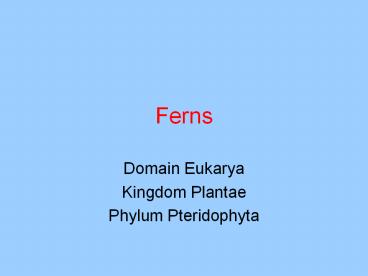Ferns - PowerPoint PPT Presentation
Title: Ferns
1
Ferns
- Domain Eukarya
- Kingdom Plantae
- Phylum Pteridophyta
2
Ferns are famous for having compound leaves Many
leaflets per frondHere are many fronds
These fronds are the visible part of the
sporophyte. All you see here is at least diploid,
but might be even-polyploid. The rhizome (stem)
and roots are not visible here.
http//www.wordplay.com/tourism/parks/ferns.gif
3
Fern fronds typically grow from an underground
stem a rhizome. Circinate vernation is the
uncoiling that the young frond undergoes to
unfurl into a fully expanded leaf. Roots grow
along the rhizome. Some ferns are covered with
hairs or scales.
4
The fronds of some ferns are very largethis is
just ONE leaf!
http//mgonline.com/mengaspp01.jpg
5
On the back side of fertile fronds, you may find
sporangia in clusters called sori.
Sori can be naked, or shrouded with an indusium
or a false indusium (a leaf edge)
http//pluto.njcc.com/ret/Roosevelt/maidsori.jpg
http//caliban.mpiz-koeln.mpg.de/stueber/mavica/a
ll/5000/04636.jpg
http//www.science.siu.edu/landplants/Pterophyta/i
mages/Dryopteris.celsa.sori.JPEG
6
In the tree ferns, the stem does grow upwards
into the air. You are not seeing branches here,
you see the rachis of each frond.
7
Tree ferns have very tall upright stems rather
than underground rhizomes. This tree fern is
living in the upper Amazon basin in Eastern
Ecuador. You can see the cluster of fronds at the
end of the stem (trunk). New fronds are emerging
with the classic fiddlehead observed as the
fronds unfurl.
8
Leaf gap
9
(No Transcript)
10
This is a cross-section of the stem of a
fern. You can see the xylem with no cytoplasm and
thick lignified cell walls. The arrows point out
phloem sieve tube elements with nearby companion
cells. At the edges of this slide you can see
cortex cells. Protoxylem is in the middle. A
mesarch amphiphloic solenostele
http//www.esb.utexas.edu/mauseth/weblab/webchap8p
hloem/web8.2-9.jpg
11
Protosteles
Specialized Versions
haplostele
actinostele
plectostele
cortex phloem xylem
dicot root
Siphonosteles
siphonostele
solenostele
dictyostele
cortex phloem xylem pith
leaf gap
leaf trace
monocot root
eustele
atactostele
dicot stem
monocot stem
12
(No Transcript)
13
Protosteles
Specialized Versions
haplostele
actinostele
plectostele
cortex phloem xylem
dicot root
Siphonosteles
siphonostele
solenostele
dictyostele
cortex phloem xylem pith
leaf gap
leaf trace
monocot root
eustele
atactostele
dicot stem
monocot stem
14
(No Transcript)
15
Phloem
Leaf gap
protoxylem
metaxylem
A mesarch amphiphloic dictyostele
16
This is a longitudinal section of a fern
root. The upper pair of arrows are marking the
apical cells of the meristem. The zone of cell
division is above this marked region. The zone of
cell elongation is above the top edge of this
view. Between the horizontal arrows is the root
cap, which provides slough cells and mucilage to
assist in soil penetration.
zone of division
apical cells
root cap
http//www.esb.utexas.edu/mauseth/weblab/webchap6a
pmer/web6.8-1a.jpg
17
This sporophyte is of Ceratopteris
richardii. This is a tropical fern whose spores
you started in laboratory. So this sporophytes
fertile fronds were harvested of their
spores. These were the dust in the vial which you
sowed onto a mineral gel.
http//www.science.siu.edu/landplants/Pterophyta/i
mages/Ceratopteris.JPEG
18
This is a view of the edge of a Ceratopteris
leaflet. The red structures are the sporangia.
http//cfern.bio.utk.edu/images/gallery/sporophyte
inpot.jpg
This is an enlarged sporangium showing the
meiospores inside.
19
(No Transcript)
20
annulus
sporangiophore
spores
lip cells
21
Here are two Ceratopteris spores. The one on the
right is rotated so you can see the tri-radiate
ridges.
These are the impressions left of the other three
spores of the tetrad made in one meiotic event.
22
The back of the Ceratopteris spore shows other
surface ridges. These are species specific and
can assist in taxonomy.
http//www.science.siu.edu/landplants/Pterophyta/i
mages/Ceratopteris.spore.JPEG
23
Here, Ceratopteris spores are germinating by
tears along the tri-radiate ridges. The rhizoids
have emerged and the young gametophyte is visible.
24
You can see that the young gametophyte is already
multicellular
http//www.science.siu.edu/landplants/Pterophyta/i
mages/Ceratop3.JPEG
25
A Ceratopteris female or hermaphroditic
gametophyte produces archegonia and a chemical
antheridiogen.
http//cfern.bio.utk.edu/images/gallery/RN10DFS.jp
g
Nearby gametophytes are then forced into male
expression by the anteridiogen. Antheridia are
visible over the male thallus. Both gametophytes
have rhizoids.
26
This Ceratopteris gametophyte shows the necks of
at least six archegonia
27
This scanning electron microgram (SEM) of a
female gametophyte shows many, many archegonium
necks.
The venters of these archegonia are embedded in a
parenchymatous pad of cells below the notch of
the female gametophyte.
http//www.science.siu.edu/landplants/Pterophyta/i
mages/fern.arch.JPEG
28
Here you can make out the embedded venter and
egg/zygote.
http//www.csus.edu/indiv/r/reihmanm/bio5_lab/fern
s_and_allies/Archegonium_side_view_MC.jpg
29
This is a cross section of the female gametophyte
which is a longitudinal section of the archegonia.
The archegonium has
Sterile Jacket
Egg
Ventral Canal Cell
Neck Canal Cells
Cap Cells
http//www.csus.edu/indiv/r/reihmanm/bio5_lab/fern
s_and_allies/Archegonium_MC.jpg
30
The cap cells of the archegonium burst when
ripe and in fresh water. The neck and ventral
canal cells disintegrate in very similar ways.
The breakdown products include malic and maleic
acids which serve as chemotactic agents to
attract sperm to the venter.
http//www.biology87.org/apbio/diversity/PlantLabP
icts/fern4.jpg
The antheridium has ring cells for a sterile
jacket, and a cap cell too. The cap cell
disintegrates as its equivalent in the
archegonium. The sperm are released in the film
of water and swim away up the concentration
gradient of the chemotactic agent.
31
In this SEM, the cap cell of the antheridium has
peeled away...
releasing the sperm cells into the water film.
http//www.science.siu.edu/landplants/Pterophyta/i
mages/fern.anth.JPEG
32
The mature sperm, with a coiled cell body, breaks
free and swims using its many flagella
http//www.science.siu.edu/landplants/Pterophyta/i
mages/Ceratopteris.sperm.JPEG
33
After syngamy, the zygote develops inside the
venter of the archegonium.
The zygote will grow into a new fern sporophyte
with leaf, stem, and root.
http//www.csus.edu/indiv/r/reihmanm/bio5_lab/fern
s_and_allies/Young_sporophyte_MC.jpg
34
The Life Cycle of Ceratopteris
is sporic (diplohaplontic)
35
This is a wild-type gametophyte
This is a polka dot mutant gametophyte
and a close-up of its cells
and a close-up of its cells































